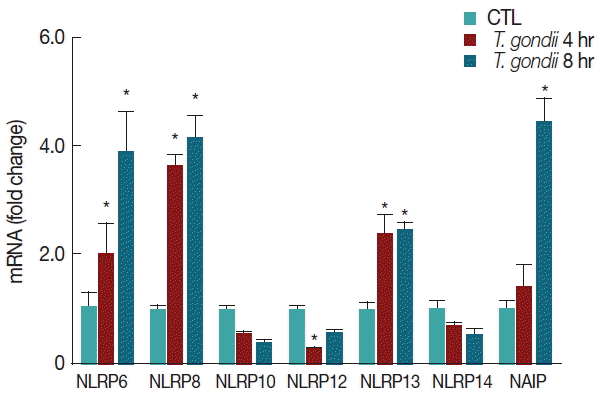Cited By
Citations to this article as recorded by

Role of Microgliosis and NLRP3 Inflammasome in Parkinson’s Disease Pathogenesis and Therapy
Fillipe M. de Araújo, Lorena Cuenca-Bermejo, Emiliano Fernández-Villalba, Silvia L. Costa, Victor Diogenes A. Silva, Maria Trinidad Herrero
Cellular and Molecular Neurobiology.2022; 42(5): 1283.
CrossRef Possible therapeutic targets for NLRP3 inflammasome-induced breast cancer
Xixi Wang, Junyi Lin, Zhe Wang, Zhi Li, Minghua Wang
Toxoplasma gondii Induces Pyroptosis in Human Placental Trophoblast and Amniotic Cells by Inducing ROS Production and Activation of Cathepsin B and NLRP1/NLRP3/NLRC4/AIM2 Inflammasome
Juan-Hua Quan, Fei Fei Gao, Tian-Zhong Ma, Wei Ye, Xiang Gao, Ming-Zhu Deng, Lan-Lan Yin, In-Wook Choi, Jae-Min Yuk, Guang-Ho Cha, Young-Ha Lee, Jia-Qi Chu
The American Journal of Pathology.2023; 193(12): 2047.
CrossRef Unraveling the NLRP family: Structure, function, activation, critical influence on tumor progression, and potential as targets for cancer therapy
Xueqing Zhou, Yongguang Tao, Ying Shi
Cancer Letters.2024; 605: 217283.
CrossRef In silico analysis of expression and DNA methylation profiles of NLRP13 inflammasome in tumor cells
Feyzanur Yildirimtepe Caldiran, Caglar Berkel, Koksal Deveci, Ercan Cacan
Host inflammatory responses to intracellular invaders: Review study
Ramesh Chandra Rai
Life Sciences.2020; 240: 117084.
CrossRef Soluble total antigen derived from Toxoplasma gondii tachyzoites increased the expression levels of NLRP1, NLRP3, NLRC4, AIM2, and the release of mature form of IL1β, but downregulated the expression of IL1β and IL18 genes in THP-1cell line
Hossein Pazoki, Hanieh Mohammad Rahimi, Hamed Mirjalali, Maryam Niyyati, Nariman Mosaffa, Seyed Javad Seyed Tabaei, Shabnam Shahrokh, Hamid Asadzadeh Aghdaei, Mohammad Reza Zali
Microbial Pathogenesis.2021; 158: 105072.
CrossRef P. aeruginosa biofilm activates the NLRP3 inflammasomes in vitro
Qi Tan, Qing Ai, Yu He, Fang Li, Jialin Yu
Microbial Pathogenesis.2022; 164: 105379.
CrossRef Toxoplasma gondii profilin induces NLRP3 activation and IL-1β production/secretion in THP-1 cells
Hossein Pazoki, Hamed Mirjalali, Maryam Niyyati, Seyed Javad Seyed Tabaei, Nariman Mosaffa, Shabnam Shahrokh, Hamid Asadzadeh Ahdaei, Andreas Kupz, Mohammad Reza Zali
Microbial Pathogenesis.2023; 180: 106120.
CrossRef Treatment of mice with S4B6 IL-2 complex prevents lethal toxoplasmosis via IL-12- and IL-18-dependent interferon-gamma production by non-CD4 immune cells
Andreas Kupz, Saparna Pai, Paul R. Giacomin, Jennifer A. Whan, Robert A. Walker, Pierre-Mehdi Hammoudi, Nicholas C. Smith, Catherine M. Miller
Latent Upregulation of Nlrp3, Nlrc4 and Aim2 Differentiates between Asymptomatic and Symptomatic Trichomonas vaginalis Infection
Sonal Yadav, Vivek Verma, Rakesh Singh Dhanda, Sumeeta Khurana, Manisha Yadav
Immunological Investigations.2022; 51(5): 1127.
CrossRef NLRP13 inflammasome complex is hypermethylated in familial Mediterranean fever and global methylation correlates with the disease severity
Feyzanur Yildirimtepe Caldiran, Koksal Deveci, Ercan Cacan
Annals of Human Genetics.2023; 87(3): 115.
CrossRef RIPK3 Facilitates Host Resistance to Oral Toxoplasma gondii Infection
Patrick W. Cervantes, Bruno Martorelli Di Genova, Billy Joel Erazo Flores, Laura J. Knoll, Jeroen P. J. Saeij
Infection and Immunity.2021;[Epub]
CrossRef NLRP3 Plays a Key Role in Antihelminth Immunity in the Enteral and Parenteral Stages of Trichinella spiralis-Infected Mice
Tian-Xu Pan, Hai-Bin Huang, Hui-Nan Lu, Guang-Xun Zhao, Yu Quan, Jun-Yi Li, Ying Xue, Zhi-Yu Zhu, Yue Wang, Chun-Wei Shi, Nan Wang, Gui-Lian Yang, Chun-Feng Wang, De’Broski R. Herbert
Infection and Immunity.2023;[Epub]
CrossRef Cytosolic Recognition of Microbes and Pathogens: Inflammasomes in Action
Jenni A. Hayward, Anukriti Mathur, Chinh Ngo, Si Ming Man
Microbiology and Molecular Biology Reviews.2018;[Epub]
CrossRef P2X7 receptor mediates NLRP3-dependent IL-1β secretion and parasite proliferation in Toxoplasma gondii-infected human small intestinal epithelial cells
Juan-Hua Quan, Rui Huang, Zhuang Wang, Shuai Huang, In-Wook Choi, Yu Zhou, Young-Ha Lee, Jia-Qi Chu
Parasites & Vectors.2018;[Epub]
CrossRef Neospora caninum infection induces an isolate virulence-dependent pro-inflammatory gene expression profile in bovine monocyte-derived macrophages
Marta García-Sánchez, Laura Jiménez-Pelayo, Pilar Horcajo, Esther Collantes-Fernández, Luis Miguel Ortega-Mora, Javier Regidor-Cerrillo
Parasites & Vectors.2020;[Epub]
CrossRef Expression profiles of NOD-like receptors and regulation of NLRP3 inflammasome activation in Toxoplasma gondii-infected human small intestinal epithelial cells
Jia-Qi Chu, Fei Fei Gao, Weiyun Wu, Chunchao Li, Zhaobin Pan, Jinhui Sun, Hao Wang, Cong Huang, Sang Hyuk Lee, Juan-Hua Quan, Young-Ha Lee
Parasites & Vectors.2021;[Epub]
CrossRef Role of inflammasomes in Toxoplasma and Plasmodium infections
Zhi-xin Wang, Wan-jun Jiao, Yong Yang, Hong-li Liu, Hai-long Wang
Parasites & Vectors.2024;[Epub]
CrossRef A Comparison of Transcriptional Diversity of Swine Macrophages Infected With TgHB1 Strain of Toxoplasma gondii Isolated in China
Yongle Song, Lindong Song, Xiaoting Wan, Bang Shen, Rui Fang, Min Hu, Junlong Zhao, Yanqin Zhou
Frontiers in Cellular and Infection Microbiology.2020;[Epub]
CrossRef The strategies of NLRP3 inflammasome to combat Toxoplasma gondii
Chanjin Yoon, Yu Seong Ham, Woo Jin Gil, Chul-Su Yang
Frontiers in Immunology.2022;[Epub]
CrossRef The role of NOD-like receptors in innate immunity
Cássio Luiz Coutinho Almeida-da-Silva, Luiz Eduardo Baggio Savio, Robson Coutinho-Silva, David M. Ojcius
Frontiers in Immunology.2023;[Epub]
CrossRef P2X7 Receptor Modulation of the Gut Microbiota and the Inflammasome Determines the Severity of Toxoplasma gondii-Induced Ileitis
Aline Cristina Abreu Moreira-Souza, Hayandra Ferreira Nanini, Thuany Prado Rangel, Sthefani Rodrigues Batista da Silva, Beatriz Pêgo Damasceno, Beatriz Elias Ribeiro, Cynthia M. Cascabulho, Fabiano Thompson, Camille Leal, Patrícia Teixeira Santana, Siane
Overview of Apoptosis, Autophagy, and Inflammatory Processes in Toxoplasma gondii Infected Cells
Ehsan Ahmadpour, Farhad Babaie, Tohid Kazemi, Sirous Mehrani Moghaddam, Ata Moghimi, Ramin Hosseinzadeh, Veeranoot Nissapatorn, Abdol Sattar Pagheh





